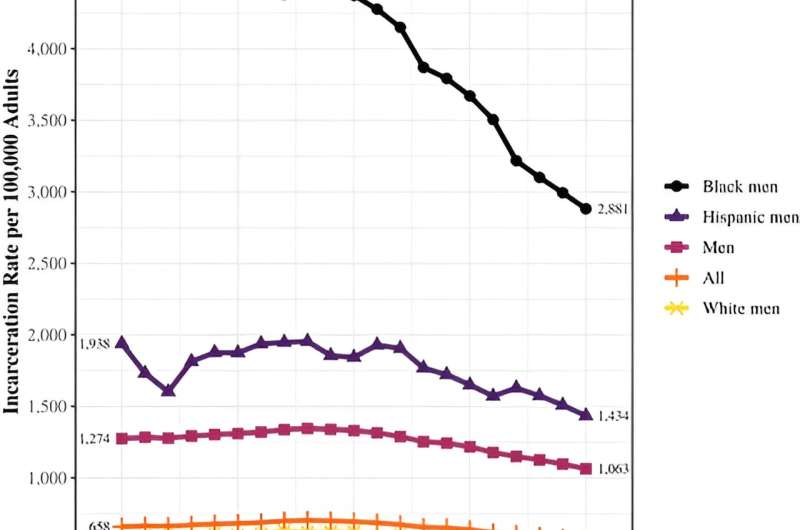This article has been reviewed according to Science X's editorial process and policies. Editors have highlighted the following attributes while ensuring the content's credibility:
fact-checked
peer-reviewed publication
trusted source
proofread
Incarceration rates, falling in every US state, drive significant shifts in risk of prison for marginalized groups

The risk of incarceration for Black men in the United States was cut nearly in half between 1999 and 2019, according to a new study that assesses the impact of falling rates of imprisonment in each of the 50 states.
Incarceration rates have dropped in every state and for every racial, ethnic and gender group (with the exception of white women) on the way to a 20% decline nationally since 2007. No group's prospects have changed as much as those of Black men.
A 2003 report concluded about one in three Black men in the U.S. would go to prison at some point in their lives, compared to 1 in 17 white men. That statistic continues to surface often in news coverage and discussions of criminal and social justice issues.
"That report wasn't wrong, but the premise then was that this was the risk if nothing changes with incarceration rates," says Michael Light, University of Wisconsin–Madison sociology professor and co-author of the new study, published recently in the journal Demography. "Even criminologists have been slow to recognize it, but we know that a lot has changed and that those changes shift the burden of incarceration off of particular groups in significant ways."
Using data from the Bureau of Justice Statistics, the National Institutes of Health, and the Centers for Disease Control and Prevention, the researchers plotted incarceration rates for cohorts of each race and gender group tracked in the statistics who were born each year from 1981-2001—that is, those who reached adulthood from 1999 through 2019.
"We tabulated all those chances, the risk, of going to prison for each group as it aged and watched the arc of that risk change for the better for nearly every group," says Jason Robey, who worked on the study as a graduate student at UW–Madison and is now a criminal justice professor at the University at Albany. "For Black men, the risk dropped from one in three going to prison by age 50 to one in five."
The risk for white men fell from a 6.2% chance of imprisonment to 4.1%. Hispanic men fell from 15.4% to 12.8%.
Avoiding prison goes hand in hand with marked improvements in the chances of other, more positive life events, the researchers showed. In 2009, 17% of the 25-year-old Black men in the U.S. had gone to prison, while 12% had graduated from college. Just 10 years later, those percentages had reversed. In 2019, 17% of the 25-year-old Black men were college grads, and 12% had been to prison.
"College graduates are far less likely to go to prison. So, a huge group of these guys have reached a kind of escape velocity and now they're almost entirely out of the risk pool," Light says. "It's an example of the self-reinforcing aspects of these imprisonment trends that makes us think they will continue."
Young Americans in general have grown less likely to break the law in recent decades, according to Light and Robey, driving much of the decrease in imprisonment. Some policy changes have contributed as well.
"The reduction has been across basically every category of crime, but states are putting fewer people in prison for drug crimes in particular," Robey says. "That's one of the areas of most rapid decline."
Falling incarceration rates for Black and Hispanic men and women have made for significant changes in racial disparities in prison populations.
The rate for Black women dipped most of any group during the study period, falling 65%. In 1999, the incarceration rate for Black women was 8.8 times higher than for white women. By 2019, it was down to 1.8 times higher. The racial disparity between Black and white men fell from 9.3-to-1 in 1999 to 6.1-to-1 in 2019.
"Those are still stark inequalities and still very high numbers. And there are states that stand out, like Wisconsin, where the Black male incarceration rate is still 14 times the white rate," Light says. "But it's important to note that across the country, this is not getting worse. It hasn't plateaued. It's getting better."
More information: Jason P. Robey et al, A Generational Shift: Race and the Declining Lifetime Risk of Imprisonment, Demography (2023). DOI: 10.1215/00703370-10863378
Journal information: Demography
Provided by University of Wisconsin-Madison




















